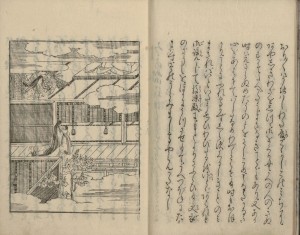
In both Anatomy of Criticism and The Secular Scripture Frye refers to Lady Murasaki’s The Tale of Genji as an example of an “endless” romance, the conclusion of which does not preclude Lady Murasaki from adding any number of additional episodes. Frye annotated his own copy of this expansive eleventh century Japanese tale of court life (trans. Arthur Waley [London: George Allen & Unwin, 1957] 1135 pp.) Frye’s annotations are more expansive than the notes he ordinarily scribbled in the margins of his books. If he were to have written an essay or a more extended commentary on The Tale of Genji, the essential core might well have come from his annotations, which are transcribed in what follows. (The numbers in parentheses following each entry are to the pages in Frye’s edition.)
The title “dwellers above the clouds” indicates that courtiers were thought of, & wished to be thought of, as leading a severe & untroubled life of pleasure & privilege. Murasaki shows them as spoiled, frustrated, and boring each other (with the women often quite literally) to death. Is the brutal selfishness of the men something she accepts as a datum of life, or something she is satirizing? The latter by implication, certainly. (46)
Interesting to know if the original has anything of the Virginia Woolfish quality of the translation. (81)
Genji reminds me of the flower known as the red-hot poker. If I were a Japanese I could make a poem out of that. (108)
When night lets fall her sable hood
How may one know which dame one scrood? (153)
The most startling feature of this wonderful story is the sense of social security—no reference to torture, imprisonment, beatings, violence, executions, or even war. In the court, life is like a modern university: when the emperor gets bored with emperoring he just quits, with no questions or upsets. Murasaki makes it clear that this security extends only to a stratospherically elevated group, but within that group, civilization is complete. (184)
The story is realistic in the sense that nothing supernatural or incredible (in her terms) occurs & in the sense that all human foibles & weaknesses are fully displayed. But there’s another feature that makes it a romance in my sense—or one of my senses. That’s her acceptance, not of her own society only, but of that society’s idealized picture of itself. People who are socially the best people, in other words, really are the best people. The exact degree of a girl’s beauty (except for Kiritsubo) depends primarily on her heredity, like a knight’s chivalry in Malory. (184).
The jealous mistress Rukujo sets up a Ligeia pattern, killing Yugao & Aoi by projecting a part of herself & bewitching them. She even speaks through them just as Ligeia does. After her death she becomes more formidable, a prowling ghoul who seizes on Murasaki. Yugao is a sleeping beauty archetype: the incarnate dream of the perfect mistress discovered in a completely isolated spot. (Not completely isolated: she’d already been discovered by Genji’s brother-in-law, who’d had a child by her, but that doesn’t bother Genji: he just wants to adopt the child. Civilized buggers.) (359)
There’s a growing sense of bondage as the story proceeds. The structure is less obviously teleological than that of a Western story: the metaphor of a horizontal [indecipherable word] picture is more than just an analogy. The reader is almost unaware of the rigidity of Japanese etiquette in the first volume. Genji is like the sun (I don’t know how much can be forced into his name Hikaru) who sees and [warms?] everyone. Wherever he goes, women strip, and wait, panting. But towards the end even Genji runs his head into screens, and the sense of barriers is all over the Kaoru section. Barriers are an obsession with Kaoru himself, and with Niow the emphasis is thrown on the hampering of an emperor’s son. What takes over, as people get increasingly bored with themselves and their amusements, is religion, in its completely anti-worldly monastic form. (538)
The disappearance & pretended death of Ukifune (“floating boat”) introduces another archetype, treated with ironic inconclusiveness. The incident that looks like a comic gimmick turns out to be a means of clinching the sense of ironic frustration increasing throughout the story. The end is a technical device permitting further continuity—touch of the primitive endless form—but a perfect end in itself. Ukifune, who’s practically a schizophrenic, is a reborn daughter & mistress, but the final recognition scene, with a young brother adroitly introduced, is left suspended with an irony that reverses the perspective. Ukifune is not dead to the world in any spiritual sense: she’s just dead; but the growing sense of unreality about the world of desire and the final feeling that the story really is endless, gives [sic] us a final aerial view with the dream of human life becoming an abstract pattern underneath. (937)
Murasaki makes considerable use of displaced characters, which are sometimes rationalized by conceptions of Karma & reincarnation. Thus a character, generally a woman, will replace or double for an earlier character whom she greatly resembles—Ukifune’s relation to the dead Agemaki. (938)
Thus Genji is the son of the Emperor and his dearly loved concubine Kiritsubo. After her death, the Emperor tries to console himself with Fujitsubo, who resembles her: Genji has a son by her supposed to be the Emperor’s. That’s straight Oedipus displacement. The little girl Murasaki is adopted by Genji because she reminds him of her aunt and his mistress. The minute the poor youngster’s vagina is big enough to hold him, in he pops, and later on when Genji’s son Yugiri sees her by accident (normally young son’s are kept away from their father’s women) he falls in love with her. This in itself comes to nothing, but Genji’s second wife has a bastard by someone else, tying up the Oedipus pattern very symmetrically. (938)
